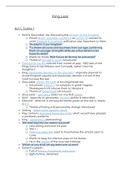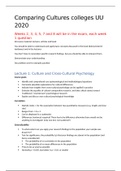CMY2601
Assignment 1
Semester 2 2023
lenovo
[COMPANY NAME] [Company address]
, CMY2601 Assignment 1 Semester 2 2023
1. Distinguish between causes, contributory factors, motives and triggers
as risk assessment criteria for reoffending behaviour. (10)
Distinguishing between Causes, Contributory Factors, Motives, and Triggers as
Risk Assessment Criteria for Reoffending Behavior:
In the context of risk assessment for reoffending behavior, it is essential to
understand the distinctions between different factors that may contribute to
criminal behavior. Let's examine each term:
a. Causes: Causes refer to the fundamental reasons or root factors that lead to
criminal behavior. These are the primary drivers that give rise to reoffending.
Causes often involve complex social, psychological, and environmental factors
that create a context in which criminal behavior becomes more likely. For
example, growing up in a violent and abusive household, experiencing poverty
and lack of opportunities, or having a history of mental illness can be
considered underlying causes of reoffending.
b. Contributory Factors: Contributory factors are additional elements that
increase the likelihood of reoffending but may not be as profound as the
underlying causes. These factors enhance the risk of engaging in criminal
behavior but are not the primary reason for it. Contributory factors could
include substance abuse, peer pressure, association with criminal networks, or a
lack of social support.
c. Motives: Motives refer to the specific reasons or goals behind a criminal act.
They provide insight into why an individual may choose to commit a particular
offense. Motives can be diverse and may include financial gain, revenge, a
desire for power or control, or an expression of anger. Identifying motives helps
in understanding the intent behind the reoffending behavior.
Assignment 1
Semester 2 2023
lenovo
[COMPANY NAME] [Company address]
, CMY2601 Assignment 1 Semester 2 2023
1. Distinguish between causes, contributory factors, motives and triggers
as risk assessment criteria for reoffending behaviour. (10)
Distinguishing between Causes, Contributory Factors, Motives, and Triggers as
Risk Assessment Criteria for Reoffending Behavior:
In the context of risk assessment for reoffending behavior, it is essential to
understand the distinctions between different factors that may contribute to
criminal behavior. Let's examine each term:
a. Causes: Causes refer to the fundamental reasons or root factors that lead to
criminal behavior. These are the primary drivers that give rise to reoffending.
Causes often involve complex social, psychological, and environmental factors
that create a context in which criminal behavior becomes more likely. For
example, growing up in a violent and abusive household, experiencing poverty
and lack of opportunities, or having a history of mental illness can be
considered underlying causes of reoffending.
b. Contributory Factors: Contributory factors are additional elements that
increase the likelihood of reoffending but may not be as profound as the
underlying causes. These factors enhance the risk of engaging in criminal
behavior but are not the primary reason for it. Contributory factors could
include substance abuse, peer pressure, association with criminal networks, or a
lack of social support.
c. Motives: Motives refer to the specific reasons or goals behind a criminal act.
They provide insight into why an individual may choose to commit a particular
offense. Motives can be diverse and may include financial gain, revenge, a
desire for power or control, or an expression of anger. Identifying motives helps
in understanding the intent behind the reoffending behavior.





